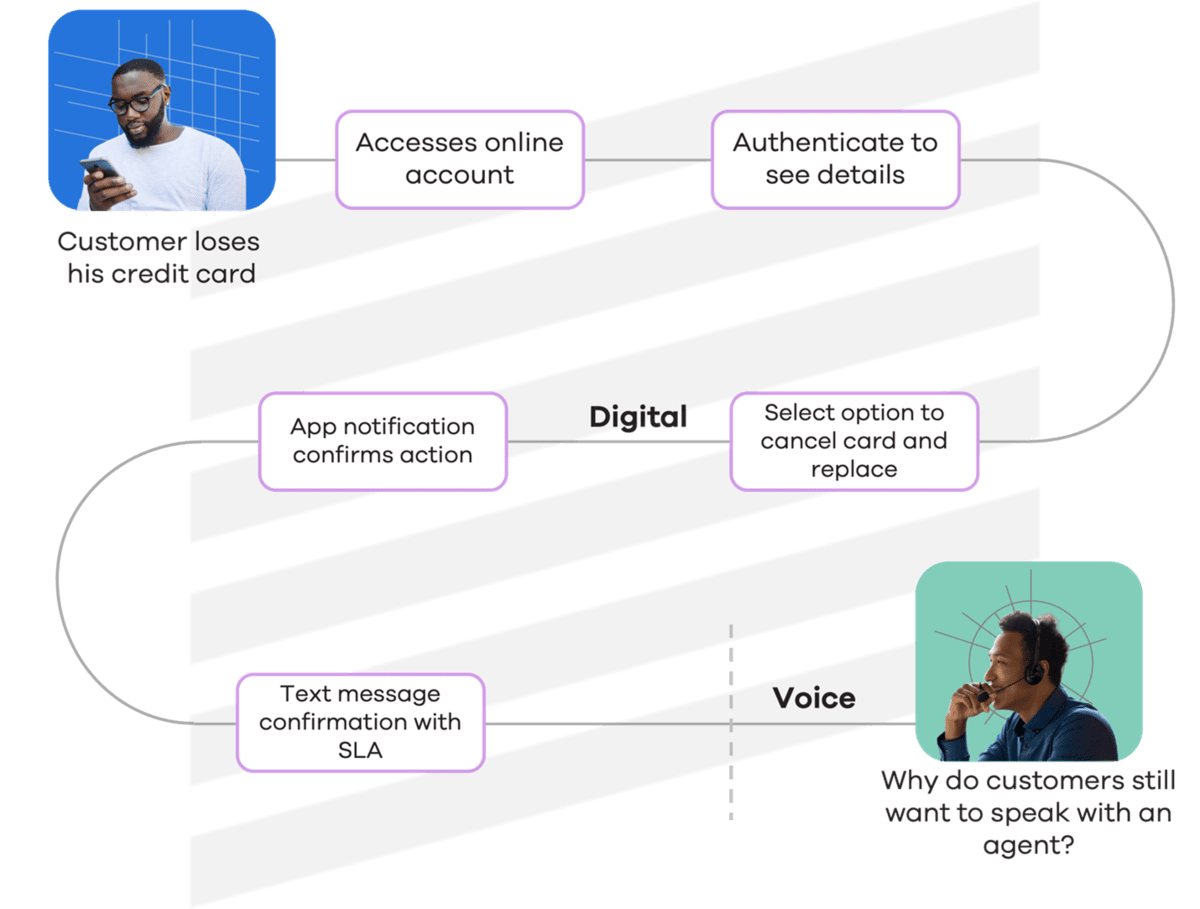The voice channel is dead, and other myths about digital adoption.
A number of years ago, analysts predicted a dramatic shift of customer interactions from voice to digital self-service channels. With disruption looming, we saw many organizations scramble to prepare for the nirvana of the Omnichannel Customer Experience. So, a few years into the forecast, how are we tracking? In recent conversations I unpacked an interesting theme being felt by leading organizations who have, in fact, moved rapidly to customer self-service deflection – the Reassurance Cycle. This blog covers where we are at with self-service adoption, the challenges organizations are facing, and why voice is still king for many organizations.
What is customer self-service deflection?
Customer self-service deflection is about providing customers an alternative way to problem solve. The purpose of customer self -service is not only to reduce the cost to serve, but it also focuses on meeting customers in their channel of choice- whenever and wherever they need support.
Deflecting a customer to self-service has various options:
- Customer portals
- FAQs + troubleshooting guides
- Virtual assistants
Depending on an organization’s digital maturity, the number of self-service channels they offer will vary.
Which inquiries are best suited to self-service?
Traditionally, organizations have focused on sending high volume, low value transactions to digital channels. These repeat inquiries are thought to be easier for a customer to navigate on their own. Depending on the industry, simple transactions look like:
- Updating your contact details (name, address, phone number)
- Finding your nearest health provider
- Cancelling a lost credit card
- Resetting a modem
So, if the channels are clear, and the transactions are simple to segment, then what’s the problem?
The Reassurance Cycle
Increasingly, customers are seeking reassurance from a human that their query is on its way to being resolved. Organizations that have worked hard to introduce digital channels into the mix for their customers are finding it hard to forecast when and where their customers will land.
Let’s look at a recent example that I analysed.
A large financial institution has introduced chatbot and self-service portals via mobile app and desktop to their customers. The bank identified that “Cancel a lost or stolen card” was a prime candidate to offer in the digital channel. They forecasted that a large portion of the calls / chats to their contact center would deflect based on creating this seamless 24/7 option for their customers.
When a customer loses their card they can now access their account via portal or app, authenticate to see their account details, select to cancel a card, and order a new one. Once completed, their app is updated, and for extra transparency, a text message is also sent with SLAs and helpful tips. Seems simple, right? Interestingly, the call queue for lost cards is in fact busier than ever. And although customers are starting their transaction in the digital channels, they are reverting back to voice for reassurance from a person that their card is cancelled and on the way. This trend is causing forecasting chaos for the bank. Now they feel like they can’t predict volumes across channels or determine how many agents they need.

Predicting the reassurance cycle
When chatting with contact center leaders and analysing interactions, the need for reassurance can be predicted by:
Customer persona – It’s not as simple as Gen X vs. Gen Y. Age, location, willingness to opt into self-service and digital maturity/comfort all play a role.
Trust in an organization – Based on past interactions, how consistent and accurate is the information that has been provided?
External factors – Influences (sometimes) outside of an organization’s control; data breaches, audit findings, and the looming recession all play a role here.
Emotional Connection –Problems relating to health, finances, and large life decisions evoke feelings of anxiety. When the customer has an emotional connection to their problem, they need to speak to an agent.
Supporting the voice channel
Investing in technology such as Upland InGenius is critical to supporting and maximizing the efficiency of your voice channel. Afterall, for many customers it’s the final stop. Whether they feel like self-service has failed them. Or perhaps the reassurance need is just too high, a seamless switch to an agent is a game changer in the customer service landscape. As soon as that call drops in, you need your agent to be ready. You need your customer data, and you need to understand how else they have engaged with you.
At Upland InGenius, our role is to make the agent’s life easier by connecting the systems they use, in a single view. This means less time searching for customer information and navigating tools, and more time actively listening to the customer’s concerns. Customers gain reassurance through confident, consistent service, and at Upland, enabling that experience is our speciality.
Should your business still be focusing on digital channels? Absolutely. Does it mean it’s time to switch off the phones to your customers? Definitely not.
We recently produced a podcast about how personalization is a game changer for customer experience and satisfaction, and how InGenius can help.
If you would like to know more about how InGenius can connect your telephony to your CRM and power up agent efficiency, get in touch with the team for a demo.



